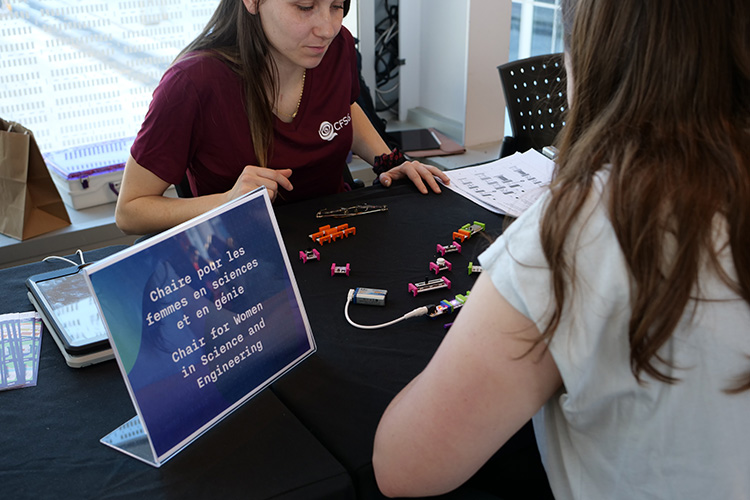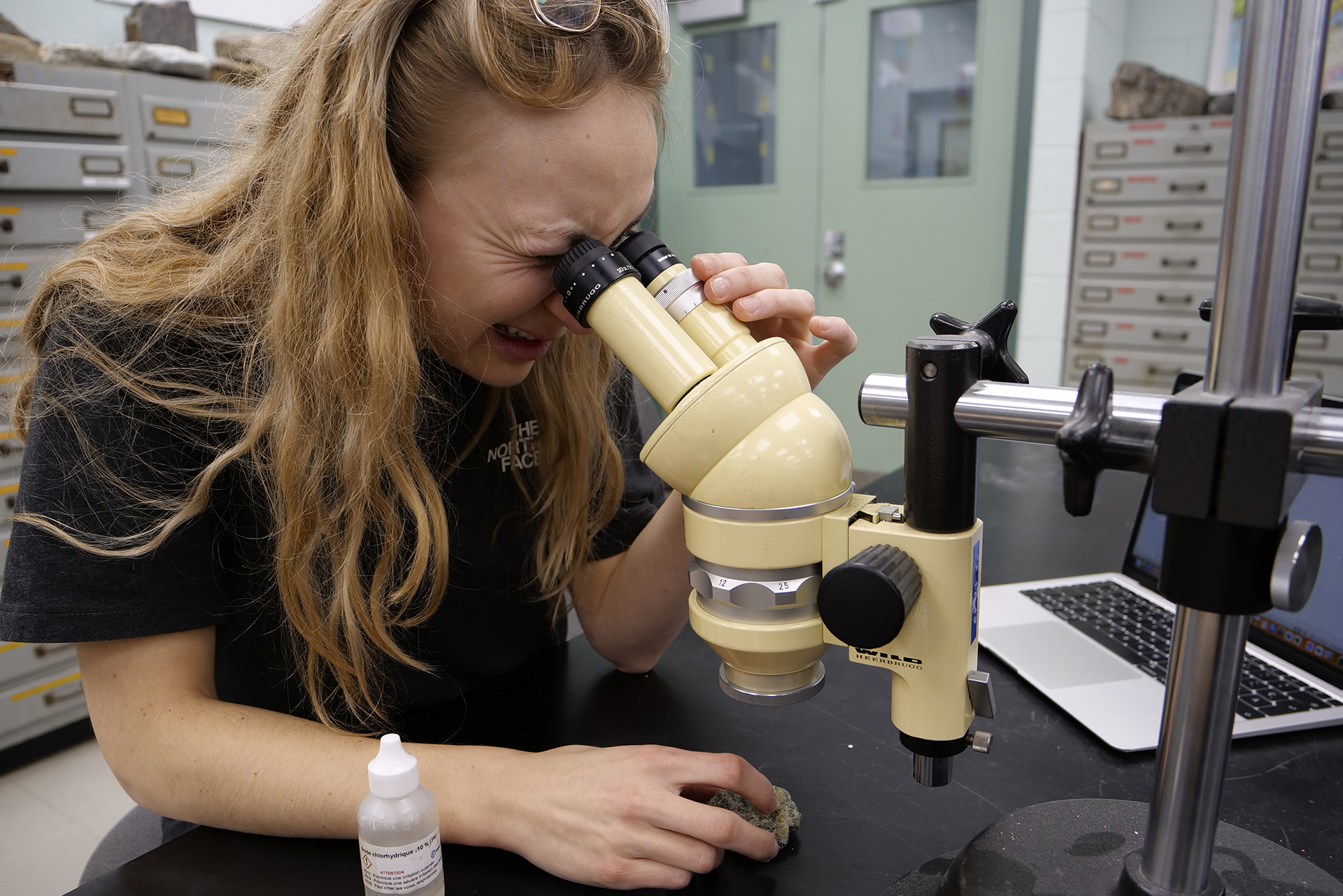BY Maggy McDonald & Mélanie Lussier
You’re working in a remote town north of Québec. More specifically Fermont. You’re the project manager of a major environmental project and the only woman on the site. Someone is making you feel very uncomfortable.
After telling him many times, he finally stops. You get so frustrated you end up crying out of anger.
That’s Tyler Ball’s story.

Tyler Ball working from her home office. Photo by Maggy McDonald.
“I thought: Great! Now, I am the emotional woman. Exactly what they expected. I was reinforcing the stereotype that women are emotional,” says Ball, an engineer specializing in water treatment.
“Can I separate my role from just being a woman in society?” Ball asks. She says she believes that women’s role in society is still thought of as very traditional.
However, women are leading in health fields and represent 80.2 per cent of the workforce.
“It’s the human aspect of helping, which is very important [to women],” explains Eve Langelier, head of the Chair for Women in Science and Engineering in Quebec.
But, women aren’t doing nearly as well in jobs such as trades, transport, and equipment operators. As of 2022, women made up only 6.4 per cent of workers in these fields. Those numbers have only increased by 1.9 per cent in the last two decades.
In 2023, women truckers are still trying to carve out their place in Quebec’s route transportation industry. Video by Mélanie Lussier.
In 2021, according to the 2005-2021 report by the Chair for Women in Science and Engineering of Quebec, women made up 43 per cent of applications for a Bachelor in applied sciences and 28 per cent in engineering fields in Quebec.
For engineering in particular, 15 per cent of the members of the Order of Engineers of Quebec were women in 2022. According to Statistics Canada, in Quebec, women made up only 23.9 per cent of the workforce in natural and applied sciences in 2022.
This statistic has increased by only 2.6 per cent in the last 20 years.
This graph is based on the 2005-2021 report by the Chair for Women in Science and Engineering of Quebec. Media by Maggy McDonald.
“There was a progression in the late 90s, early 2000s. It went up faster but now it stagnates,” says Langelier. She explains that it all comes down to how we educate children. “There are studies that show that, at the age of six, young girls see intelligence and engineering as more masculine. We need to tackle early childhood and how we teach science.”

A researcher from the Chair for Women in Science and Engineering of Quebec is doing an activity with a visitor at the Women and Girls of Science event at the Montreal Science Center. Photo by Maggy McDonald.
Sophie Larrivière-Mantha, president of the Order of Engineers of Quebec, believes that one of the causes is a lack of role models for young girls.
The Montreal Science Center organizes an event called Women and Girls of Science with a mission to boost careers in science and technology. During this event, they invite guest speakers to give conferences, have workshops and demos, and set up a career space.
“As young girls progress in their careers, they may have fewer role models,” says Cibèle Robichaud, director of the Montreal Science Center. “That is why events like [Women and Girls of Science] give inspiring women the space to talk and meet with the visitors.”
To counter stereotypes and represent women in science to young girls, the Society for Canadian Women in Science & Technology (SCWIST) is trying to encourage youth towards these fields.

Children playing at the Women and Girls of Science event at the Montreal Science Center. Photo by Maggy McDonald.
“We try to connect children and teenagers with more science and science-related concepts and fields to offer them more knowledge about the options of careers that are out there and keep them interested in science,” says Maryam Leclerc, Youth Engagement Coordinator for SCWIST in Québec. “We try to make science a little more fun for them.”
SCWIST also has an e-mentoring program where they pair a female professional in the Science, Technology, Engineering, and Mathematics (STEM) fields with secondary four or five students that are interested in the same field.
“The purpose is really to help these young girls have a better self-identity of who they are in STEM and feel like they have self-efficacy,” explains Leclerc. “It is easier to do that once you had that mentor or that role model validate you, giving you advice, helping to support you, reinforcing your beliefs. It’s motivating.”
For Camille Perron, a geological engineering student at Polytechnique University, networking is really important. “I never wanted to work in the mining industry when all my directors would be men until I met an engineer at a recruitment event. When I spoke to her about my apprehensions, she understood where I was coming from and she reassured me. She was so inspiring that now I want to do my next internship in the mining industry.”

Camille Perron is studying minerals in a laboratory at Polytechnique University. Photo by Mélanie Lussier.
She says that where she felt most uncomfortable was not in school, but during her internships. “It’s always the little comments like ‘the guys are working faster when you are here.'”
She also says that, when talking with her schoolmates, she found that the workers listen more to the interns who were men than those who were women.
Tyler Ball also says networks are really important even once you are in your career: “When I got back to [my job], after my second child, I started paying attention to the leaders and the managers and there were not a lot of women,” she says.
Ball explains that the office of the president was made of 10 members, with only one woman who was working in the human resources department. During an employee meeting, she asked the CEO why and got a standing ovation.
“After that, I recruited a few of the highest-level female managers that I could find and started a network,” she says, adding that she believes a good network of women in your field can help lower the chances of discrimination.
“Traditionally, people do have this habit of discounting women’s ability to be strong, technical people. If you don’t have a network to help pull you along, chances are you won’t be taken as seriously as a man for the same position. You need your community, your people, as a female engineer.”
Ball climbed the ladder to a leadership role as a project manager.
“Sometimes I like to invite, in my imagination, 25-year-old Tyler into 45-year-old Tyler’s life. Just to see how she’d feel, and it would be scary. But, you don’t get to drop from little experience into managing [an engineering project],” she explains. “It’s lovely gaining experience over two decades. You hang additional knowledge onto things you already know.”




